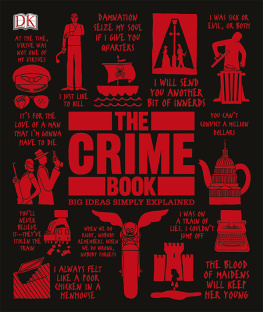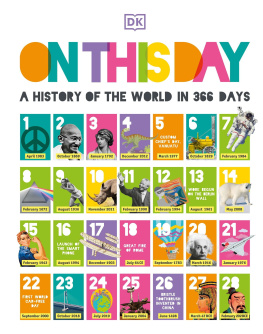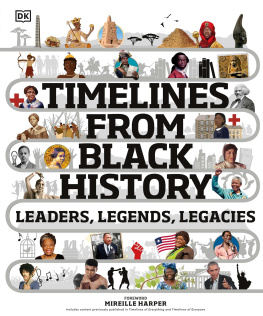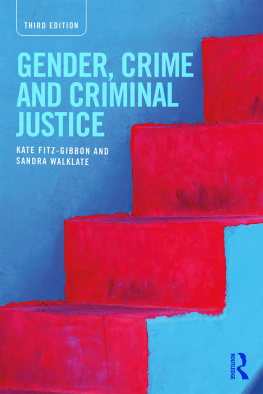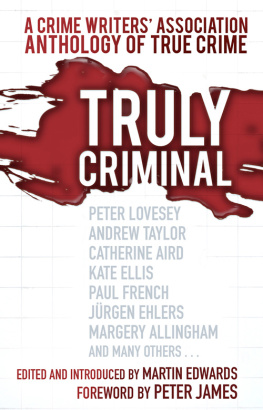CONTENTS
FOREWORD
From the Mafia-ridden streets of Sicily, Italy, to backcountry roadways of southern California traveled by Hells Angels bikers, The Crime Book features every facet of lawlessness. These high crimes and misdemeanors range from petty to deadlyall of which are spellbinding accounts within this compelling genre.
While crime is one of the greatest problems across the ages and spanning the globe, people are increasingly fascinated with the criminal mind, as evidenced by popular true-crime TV shows featuring desperados and the misdeeds they commit. Time magazine called the phenomenon a euphoric effect on human emotions that is comparable to a roller-coaster ride. With the advent of modern technology, the details of these crimes are now brought to peoples living rooms across the globe, with gavel-to-gavel televised criminal trials and news reports aired internationally in real-time.
The telling of these tragedies is so popular that the Investigation Discovery network devotes hours of air time to addictive true-crime programming, including grisly murders, such as that of the Black Dahliaa story also told in this book. It is one of the oldest unsolved murder cases in Los Angeles, California, and has been depicted in several feature films and true-crime books. The appeal is comparable to people not being able to look away from traffic accidents.
The hundred or so crimes and perpetrators featured in these pages are told by four seasoned, best-selling true-crime authorsLee Mellor, Shanna Hogan, Rebecca Morris, and Michael Kerriganalong with my own telling of tales. These stories not only give readers a look into the lives and psyche of the criminals but also examines the in-depth and often lengthy police work needed to bring the perpetrators to justice. With a rare perspective by writers with expert vantage points, these chapters thoroughly examine across continents and decades, all genres of crime, including the first known homicide committed against a Neanderthal man 430,000 years ago.
In telling some of these tales, these accomplished writers followed the footsteps of street-weary detectives and sometimes cagey, tough-to-catch crooks. They include the modern-day impersonator Frank Abagnale, Jr., of Catch Me if You Can movie fame, and the glamorous life of elusive international jewel thief Doris Payne, who escaped authorities not once, but three times.
As a fact-based crime journalist and author for more than two decades, I am fascinated by these stories. I followed newspapers articles as a teenager and dreamt of one day being able to follow a case from beginning to end by writing about it. That goal was realized when I became a newspaper reporter in 1987 and an author a decade later.
During my journalism career, I have been particularly attracted to domestic violence cases, having been a victim myself for six years. I understand first-hand what womenand sometimes mengo through, and why they find it difficult to leave.
My first brush with crime, however, occurred during my second year of college, and it stayed with me. I grew up in a crime-free, middle-class suburb of San Diego, California, with near-perfect weather and safe neighborhoods. So, it was shocking when, on a spring night, I became a target, along with my twin sister and two neighborhood girlfriends. We took a weeknight jog just as we had dozens of times before. We never felt at riskthat is, until a man stepped out of the darkness, naked from the waist down. We screamed and ran to a neighboring house, from where we called police. Because of our descriptions of his nearby car, police quickly located him. Officers did not witness the indecent exposure, so I was designated as the one to make a citizens arrest, right there on the street. Weeks later, as we gathered at the courthouse to testify against him, the suspect pleaded guilty minutes before the trial was to begin.
Criminal law has fascinated me ever since. My hope is that you too will be just as fascinated by the variety of offences included in the following true accounts in this book.
Cathy Scott
Author, Murder of a Mafia Daughter and The Killing of Tupac Shakur


INTRODUCTION
Crimesthe illegal actions that can be prosecuted and are punishable by laware all around us, from comparatively petty misdemeanors to truly heinous acts of unspeakable evil.
The perpetrators of these varied transgressions have long fascinated academics and the wider public, who have sought answers to questions about whether some people are more likely to commit crimes than others, and whether there are certain characteristics unique to criminals.
Indeed, the Ancient Greeks were fascinated by the science of physiognomythe study of how certain facial features can reveal something about a persons character or nature. While such a thought now sounds somewhat ridiculous, physiognomy was widely accepted by the Ancient Greeks and underwent periodic revivals over the centuries, the most notable spearheaded by Swiss writer Johann Kaspar Lavater in the 1770s.
What unites the crimes covered in this book is their status as notorious in one way or another. Whether it is because of their breathtaking ingenuity, brazen opportunism, machiavellian scheming, or abominable malevolence, these crimes stand out over the centuries. While many of the perpetrators are viewed with distaste and disgust, some have been highly romanticized over the years for their rebelliousness and contempt for obeying the rules. This is often in spite of the extremely serious nature of their crimes, such as with Bonnie and Clyde, the Great Train Robbers, and Phoolan Devi.
Some cases have broken new ground, and in some instances have led to the swift passage of new laws to protect the public and deter others from committing similar crimes. Public outrage during the investigation into the highly publicized Lindbergh Baby kidnapping in 1932 prompted Congress to enact the Federal Kidnapping Act just one month later. Also known as the Lindbergh Law, the Act made kidnapping a federal crime punishable by death.
Other cases have involved pioneering legal defense strategies, such as with the 1843 case of Daniel MNaghten, the first of its kind in UK legal history. MNaghten was acquitted of a high-profile murder based on a criminal-insanity defense, and remanded to a State Criminal Lunatic Asylum for the remainder of his life.
"Laws are like cobwebs, which may catch small flies, but let wasps and hornets break through."
Jonathan Swift
Crime through the years
Throughout history, pivotal moments have brought new crimes to the fore. In the late 19th century, for example, lawlessness increased with the growth of towns and cities, in part because of a lack of official police forces to rein in outlaws and bring them to justice. One of those was the Wild Wests Jesse James and his infamous JamesYounger Gang, who became the first gang in the US to rob trains and banks during daylight hours.
During the Prohibition period in the US, from 1920 to 1933, organized crime proliferated when outfits such as Chicagos Sheldon Gang vied to become the major liquor suppliers in the citys southwest Irish belt.
The number of offenses in the US increased so much during that time span that the International Association of Chiefs of Police began to compile crime statistics. This culminated in the release of the Uniform Crime Reportsthe first published in January 1930which were pulled together via a voluntary cooperative effort from local, county, and state law enforcement agencies. This became a vital tool to monitor the number and types of offenses committed across the US. It caught on and inspired law enforcement agencies in other countries around the world to follow suit.

